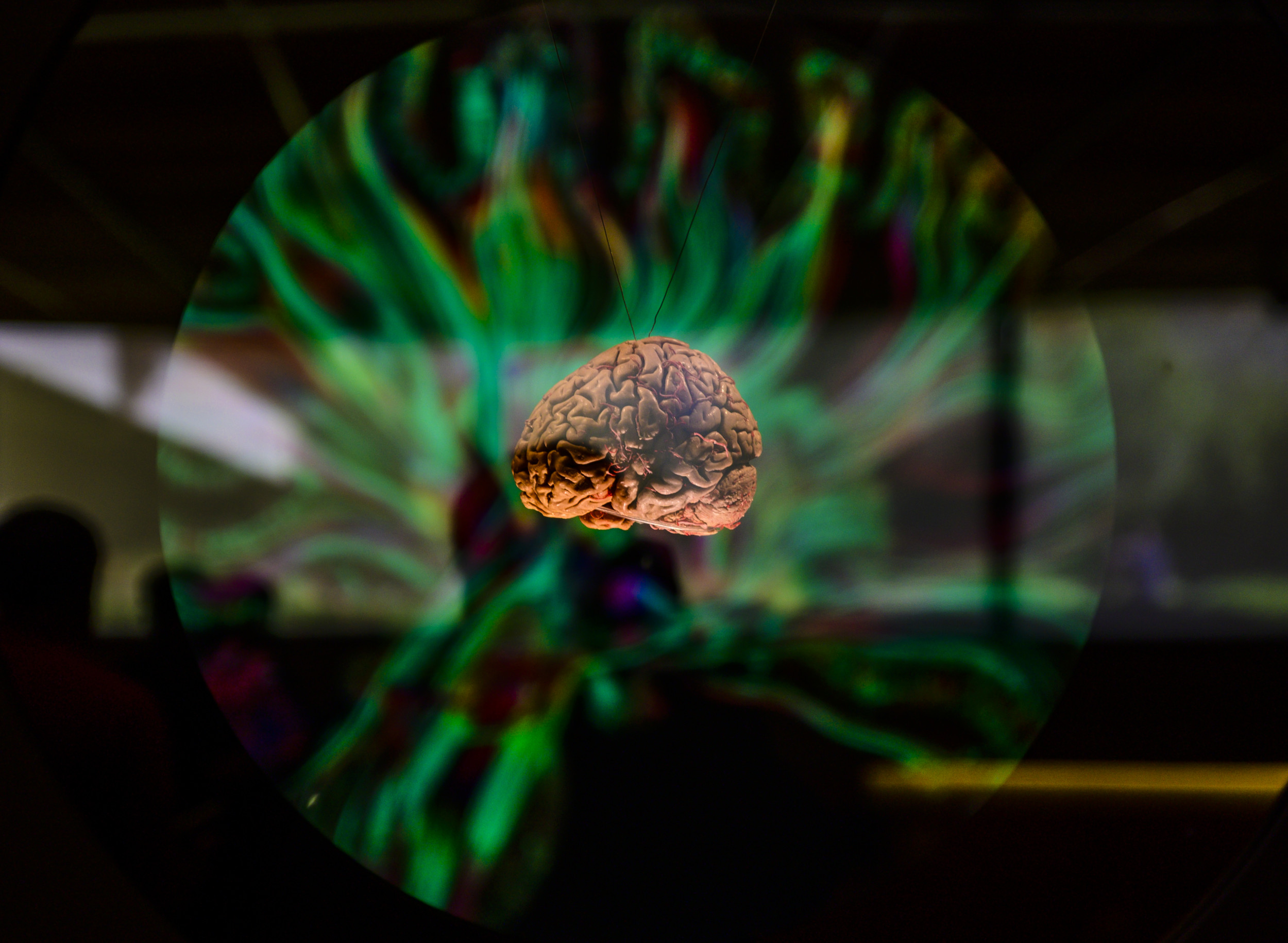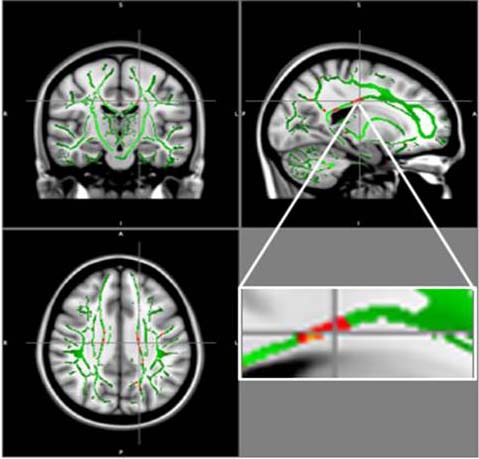肥胖与青少年脑损伤有关,扫描显示与情绪、认知功能和食欲控制相关的区域受损。
科学家们的研究将于下周在北美放射学会(RSNA)上发表,他们说这些变化可能与神经系统炎症有关。
“我们的地图显示了大脑变化与瘦素和胰岛素等激素之间的正相关关系,”该研究的合著者帕米拉·贝尔托拉齐说,她是巴西圣保罗大学的博士生和生物医学科学家声明。
“此外,我们发现炎症标记物有积极的联系,这使我们相信除了胰岛素和瘦素抵抗之外,还有一个神经炎症过程。”
贝尔托拉齐和他的同事们在分析了59名肥胖青少年的核磁共振扫描,并将扫描结果与61名健康青少年的扫描结果进行了比较后得出了这个结论,这些健康青少年的年龄都在12岁到16岁之间。
研究人员使用了一种叫做扩散张量成像的技术。这使得科学家能够监测水沿着大脑信号传导白质束的分布,作为大脑损伤的直接测量。具体来说,他们使用了一种叫做分数各向异性的测量方法——分数各向异性的减少与脑白质的更大损伤直接相关。

葡萄牙里斯本卡洛斯特·古本江基金会展示的人脑模型。扫描显示肥胖青少年大脑白质受损。
在肥胖青少年中,扫描显示大脑中与情绪控制和奖励相关的区域(眶额中央回)以及胼胝体一束2亿根被称为轴突的神经纤维,将大脑的一个半球连接到另一个半球。它的工作是为与运动、感觉和认知功能相关的信息从左半球或右半球传递到另一个半球提供桥梁,反之亦然。
这种损害与瘦素和胰岛素等激素水平较高有关。第一种是由人体脂肪细胞产生的,与食欲和脂肪储存的调节有关。瘦素抵抗会导致人们继续进食,即使身体有足够(或过量)的脂肪储备,并导致更多瘦素的产生。第二种是在胰腺产生的,有助于控制血糖水平。肥胖会导致胰岛素抵抗,从而增加一个人患2型糖尿病的风险。
Bertolazzi说,进一步的研究需要显示炎症是否是由大脑结构变化引起的,并确定这一过程是否可以逆转。
“将来,我们希望在这些青少年接受多专业减肥治疗后,对他们进行脑部核磁共振成像检查,以评估脑部变化是否可逆,”她说。
这美国疾病预防控制中心称儿童肥胖是“一个严重的问题”截至2015-2016年,39.8%美国成年人和18.5%符合肥胖标准的美国儿童。这包括18.4%6到11岁的儿童20.6%12到19岁的青少年。研究人员说,这是20世纪70年代受肥胖影响的儿童和青少年人数的三倍多。

贝尔托拉齐公司/RSNA
MRI SCANS REVEAL WHAT OBESITY DOES TO THE BRAINS OF TEENS
Obesity has been linked to brain damage in teenagers, with scans revealing impairment in regions associated with emotions, cognitive function and appetite control.
Scientists, whose study is to be presented at the Radiological Society of North America (RSNA) next week, say the changes could be related to inflammation in the nervous system.
"Our maps showed a positive correlation between brain changes and hormones such as leptin and insulin," said study co-author Pamela Bertolazzi, a Ph.D. student and biomedical scientist at the University of São Paulo in Brazil, in a statement.
"Furthermore, we found a positive association with inflammatory markers, which leads us to believe in a process of neuroinflammation besides insulin and leptin resistance."
Bertolazzi and colleagues came to this conclusion after analyzing MRI scans of 59 obese adolescents and comparing the scans to those of 61 healthy adolescents, all aged 12 to 16 years old.
The researchers used a technique called diffusion tensor imaging (DTI). This enables scientists to monitor the distribution of water along the brain's signal-carrying white matter tracts as a direct measure of brain damage. Specifically, they used a measurement called fractional anisotropy (FA)—a reduction in FA directly positively correlates to greater damage of the white matter.

A model of a human brain on display in the Calouste Gulbenkian Foundation in Lisbon, Portugal. Scans reveal damage to the brain's white matter in obese teenagers.
In obese adolescents, the scans revealed lower FA values in areas of the brain related to emotional control and reward (the middle orbitofrontal gyrus) as well as the corpus callosum—a bundle of 200 million nerve fibers called axons that join one hemisphere of the brain to the other. Its job is to provide a bridge for information related to motor, sensory, and cognitive functions to pass from the left or right hemisphere to the other, and vice versa.
This damage correlated with higher levels of hormones such as leptin and insulin. The first is produced by the body's fat cells and is associated with the regulation of appetite and fat stores. Leptin resistance can cause people to keep eating even if the body has sufficient (or excessive) fat stores, and results in the production of more leptin. The second is produced in the pancreas and helps control blood sugar levels. Obesity can cause insulin resistance and thus, increase a person's risk of developing type 2 diabetes.
Bertolazzi says further research will need to show whether or not the inflammation is caused by structural changes in the brain, and determine whether or not the process can be reversed.
"In the future, we would like to repeat brain MRI in these adolescents after multi-professional treatment for weight loss to assess if the brain changes are reversible or not," she said.
The U.S. Centers for Disease Prevention and Control (CDC) calls childhood obesity "a serious problem." As of 2015-2016, 39.8 percent of U.S. adults and 18.5 percent of U.S. children met the criteria for obese. That includes 18.4 percent of children aged 6 to 11 and 20.6 percent of adolescents aged 12 to 19. This is more than three times the number of children and adolescents affected by obesity in the 1970s, the researchers say.

BERTOLAZZI AND CO./RSNA






